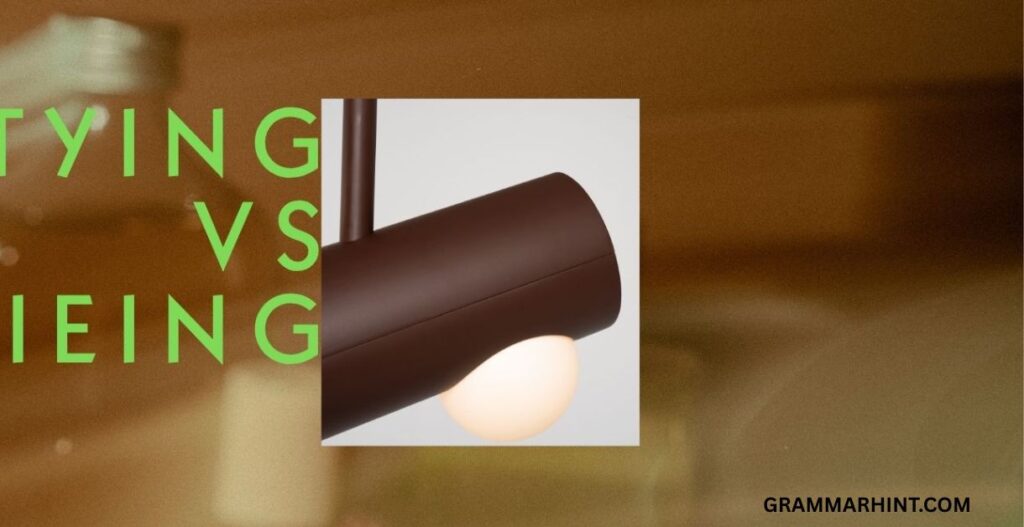If you’ve ever paused while writing and asked yourself, “Is it tying or tieing?”, you’re not alone. This kind of spelling confusion happens more than you’d think, especially with English spelling rules that aren’t always straightforward.
Whether you’re drafting an important email or helping a child with homework, knowing the correct spelling of tying can save you from making a common grammar mistake that sticks out like a sore thumb.
Let’s dive into the proper verb spelling of “tie,” its transformation into a present participle, and why “tying” is right while “tieing” is just plain wrong.
What’s the Confusion? Is It Tying or Tieing?
The confusion begins when we look at the base verb: tie. People often assume they should just add “-ing” to the end and get tieing makes sense, right? Not quite. That’s where English spelling rules come into play, especially the one known as the -ie to -y rule.
Mnemonic: Change -ie to -y, and you’ll never cry TYING is the way to comply!
Tying follows standard spelling transformations used when converting certain verbs into their present participles.
The Grammar Rule: Drop the -ie, Add a -y Before -ing
Here’s the golden rule:
“Change -ie to -y before adding -ing.”
This rule applies to many verbs ending in “-ie.” When forming their present participles, you drop the “-ie,” switch it to a “y,” and then add “-ing.”
Examples:
- Lie → lying
- Die → dying
- Tie → tying
So, how do you spell tieing? You don’t—because tying is the correct spelling.
Quick Table: The Drop -ie Rule
| Base Verb | Incorrect Form | Correct Form |
|---|---|---|
| die | dieing | dying |
| lie | lieing | lying |
| tie | tieing | tying |
Real-World Scenario Examples: Tying in Context
📧 Email Example:
Subject: Request for Packaging Materials
Hi Jamie,
Could you please send over a fresh batch of twine? We’re running low, and we’ll be tying up packages all day tomorrow for shipping.
Thanks,
Anna
📝 Writing Example:
“He spent the morning tying ropes to the dock posts, making sure every knot was secure before the storm hit.”
In both examples above, you can see how tying in daily use appears naturally in emails and written content. You’ll never find “tieing” in professionally edited documents or trusted publications.
Why Not “Tieing”? Let’s Look at the Mistake
The word tieing mistake often appears in beginner writing or informal notes. Even auto-correct tools may let it slide, but make no mistake: it’s incorrect. “Tieing vs tying” isn’t a stylistic choice—it’s a matter of spelling rules in English.
“Ying is the correct spelling, not tieing.”
Comparison with Other Words:
Let’s look at some common verb suffix changes where people get confused:
| Verb Base | Wrong Form | Right Form |
|---|---|---|
| die | dieing | dying |
| lie | lieing | lying |
| tie | tieing | tying |
This isn’t just about memorization—it’s a pattern built into English verb conjugation.
The Role of Suffix Transformations in Grammar
The ending of a word can drastically change how it’s formed. When you add suffixes like “-ing,” the spelling has to shift to maintain clarity and phonetics. That’s why verbs ending in -ie need the -ie to -y spelling rule before adding -ing.
If we didn’t apply these rules, we’d end up with awkward or unclear words. Imagine trying to pronounce “tieing.” Is it “tee-ing” or “ty-ing”? Confusing, right? That’s why spelling participles correctly matters.
A Bit of Background: Etymology of Tying
The etymology of tying takes us back to the Old English word tīegan, meaning to bind or fasten. Over time, the language evolved, and so did its verb forms. Linguistic evolution shaped modern English, streamlining verbs and creating consistent rules—like the one we follow with “tying.”
“Etymology of tying traces back to Old English.”
This linguistic change mirrors similar updates in other verbs that transitioned from complex Old English forms to more standardized present participles.
Tying vs Tieing: Grammar in Action

Let’s compare them in word usage in context:
Correct:
- “She’s tying a ribbon around the gift.”
- “He kept tying and untying the laces nervously.”
Incorrect:
- “She’s tieing a ribbon…” ❌
- “He was tieing his shoes…” ❌
The correct usage is always tying.
What About Similar Confusions Like Lying vs Lieing?
You’re not just imagining it—dying vs dieing, lying vs lieing, and tieing vs tying all follow the same error pattern. These are all spelling transformations that follow the -ie to -y rule.
| Incorrect Form | Correct Form |
|---|---|
| lieing | lying |
| dieing | dying |
| tieing | tying |
Understanding one helps you learn the others.
Synonyms of Tying and Alternatives
When writing, you don’t always have to use “tying.” Here are some tying alternatives you can rotate in for variety:
- Binding
- Knotting
- Fastening
- Securing
Tying definitions often overlap with securing something firmly in place, whether physically (like with string) or metaphorically (like tying someone to a commitment).
Tips for Remembering the Right Form
Learning how to spell correctly doesn’t have to be boring. Here are some handy grammar mnemonic and spelling memory tricks:
- Mnemonic Device: “Change -ie to -y, and you’ll never cry—TYING is the way to comply!”
- Visualize: Imagine a person tying their shoes while saying the rule aloud.
- Flashcards: Use a set for verbs ending in -ie to quiz yourself regularly.
These tools are great for students, writers, and anyone trying to master practical grammar applications.
Quick Recap Table: Tying or Tieing?
| Feature | Tying (Correct) | Tieing (Incorrect) |
|---|---|---|
| Follows -ie to -y Rule | ✅ | ❌ |
| Common Usage in English | ✅ | ❌ |
| Found in Dictionaries | ✅ | ❌ |
| Appears in Published Writing | ✅ | ❌ |
Final Word: Mastering the Tie Present Participle
So, is it tying or tieing? The answer should be crystal clear now.
✅ Tying is the correct spelling.
❌ Tieing is a spelling mistake.
By mastering these kinds of spelling rules in English, you’re not just improving your grammar—you’re boosting your confidence every time you write.
Understanding word formation in English, especially for irregular participles, makes you a better communicator. With the help of mnemonic devices, example-driven practice, and a grasp of linguistic evolution, you can say goodbye to errors like “tieing.”









